How to Choose the Right Pipe Bending Machine?
Are you in the metalworking industry and eager to find a pipe bending machine to expand your business? You may find there are many types of pipe bending machines in the market and you don’t know which type of machinery fits your needs. Today, we will give you a comprehensive understanding of pipe bending machines, you will know how to choose the right pipe bending machine to meet your production needs or you can consult with our engineer.

What is Pipe Bending Machine?
Pipe bending machine is a specialized equipment that is used for bending metal tubes and pipes into various shapes and angles. This bending equipment is highly versatile in the industrial sector, designed specifically to deliver precise pipe bending. It comes in various types to cater to different bending requirements.
Types of Pipe Bending Machine
In the industrial production field, there are 10 common types of industrial pipe bender. Let’s take a look at their respective characteristics.
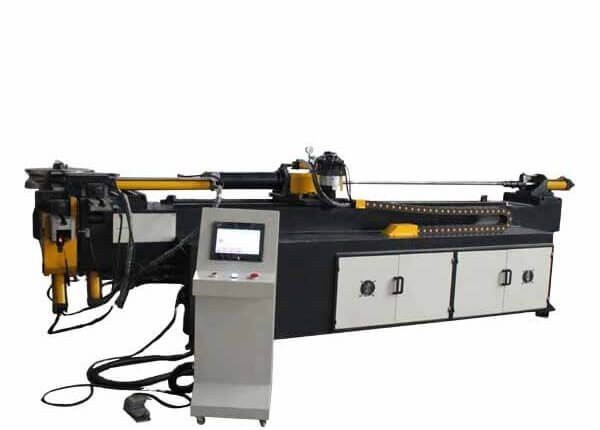
Mandrel Bender
Mandrel bender is a type of pipe bending machine used to bend pipes and tubes in precision size without distortion. The main feature of mandrel pipe bending lies in its utilization of a mandrel inserted into the portion of the tube to be bent, preventing collapse or wrinkling during the bending process.
How to Use Mandrel Bender?
Mandrel benders from different manufacturers may have different construction, so they will have slightly different in uses. The general steps in how to use the mandrel tubing bender are:
- Set Up: Make all preparations before bending the pipe, including setting the bending radius, bending angles, and other parameters set up.
- Insert Mandrel: Insert the mandrel into the tube or pipe that needs to be bent, the mandrel should extend to the entire length of the section that needs to be bent, this could avoid the pipe collapsing or wrinkling.
- Secure Material: Firmly secure the pipe or tube in place with the bending die to ensure it remains in position during the bending process.
- Start Bending: Generally, a foot switch is used to turn on the mandrel bending machine. The machine will gradually apply pressure to the material, and then bend it around the bending die while the mandrel maintains internal support.
- Monitor Process: Even if you are using the CNC pipe bender, you still need to monitor the bending process, especially when you start to bend a new project. Monitor the process and see if the bending result is smooth and even.
- Remove Bent Material: Once the bending process is finished, remove the pipe or tube from the machine.
Advantages of Mandrel Bender
As the most common industrial pipe bending machine, the mandrel pipe bender has its unique advantages.
Reduce Deformation
Compared to other bending methods, mandrel pipe bending can greatly reduce the risks of pipe collapsing or wrinkling during the bending process.
Improve Bend Quality
The use of a mandrel can ensure consistent bend quality and accuracy, and keep the precise bends with uniform wall thickness.
Versatility
The mandrel tube bender is versatile and can bend various types of metal tubes, including carbon steel, stainless steel, aluminum, copper, titanium, etc.
Increased Flexibility
Mandrel tube bender allows for complex tube bends and configurations. With such equipment, you can reach out to the higher end of the market to meet their pipe bending needs.
Cost Efficiency
Mandrel bending reduces the need for post-processing and rework, this helps to save the cost in production and manufacturing.
High Production Efficiency
Mandrel pipe bender can adjust the bending speed, so you can adjust the pipe bending speed according to your production request.
Disadvantages of Mandrel Bender
After understanding the pros of mandrel bender, let’s take a look at the cons of mandrel bender.
Higher Cost
Typically, pipe benders with mandrels have a higher cost than pipe bending machines without a mandrel.
Increased Setup Time
Every time you change to a new job, the setup time for the mandrel bending machine will take longer. You need to select and install the appropriate mandrel and other accessories.
You may interested in more about mandrel bender.
How to Choose the Tube Dies for Mandrel Pipe Bending Machine?
Some tube designs are relatively simple, while others are more complex. You need to choose different molds based on the specific tube design.
One Pipe, One Die
For a single pipe, regardless of the number of bends or the bend angle (which should not exceed 180°), it’s preferable to maintain a uniform bend radius. Since it’s one pipe per die, what’s the suitable bend radius for pipes of different diameters? The minimum bend radius depends on material characteristics, bend angle, allowable thinning of the outer wall after bending, wrinkling on the inner wall, and the ovality at the bend. Generally, the minimum bend radius should not be less than 2–2.5 times the pipe’s outer diameter, and the shortest straight section should not be less than 1.5–2 times the pipe’s outer diameter, with exceptions for special cases.
One Pipe, Two Dies (Compound Die or Multi-Layer Die)
In cases where achieving one pipe to one die is not feasible, such as limited assembly interface space or restricted pipe alignment, resulting in the need for multiple radii or short straight sections on a single pipe, double-layer dies or multi-layer dies, or even multi-layer compound dies should be considered when designing the bending die.
Multiple Tubes, Single Die
“Multiple tubes, single die” means that tubes of the same diameter should preferably use the same bending radius, employing the same set of dies to bend different shapes of pipes. This helps to maximize the compression of specialized process equipment, reduce the production volume of bending dies, and thereby lower production costs.
In general, using only one bending radius for tubes of the same diameter may not meet the assembly needs in practical positions. Therefore, 2 to 4 bending radii can be selected for tubes of the same diameter to meet actual requirements. If the bending radius is taken as 2D (where D is the outer diameter of the tube), then 2D, 2.5D, 3D, and 4D can be chosen. However, the proportion of these bending radii should be selected according to the actual layout of the engine space, avoiding excessively large radii. The number of bending radii should also not be excessive, as it may negate the benefits of multiple tubes and a single die.
How to Calculate Ovality of Bent Pipes?
When operating, the pipe bender subjects circular cross-sections to elliptical deformation due to internal pressure stress. This results in minor and major axes. Additional stress occurs at the major axis, considered as localized stress. Greater ellipticity leads to higher additional stress, potentially causing local plastic deformation and reducing the bending capacity to failure.
Hence, technical specifications strictly regulate pipe ellipticity, including:
- Protecting formed dimensions during pipe bender adjustment to prevent deformation. Initial inspection must ensure that formed dimensions remain intact.
- Moderating bending speed to prevent hard pipe rupture, wrinkling, or severe deformation (visual inspection).
- Measuring bending deformation:
- After bending, measure the minor axis using a caliper at the location with the greatest deformation. The formula for deformation is:
Deformation = (Pipe diameter – Minor axis dimension) / Pipe diameter × 100%
- For pipes with wall thickness ≥1.0, deformation should be ≤10%. For those with wall thickness <1.0, deformation should be ≤15%.
- After bending, the hard pipes should easily fit into bending gauges without forceful insertion into positioning slots.
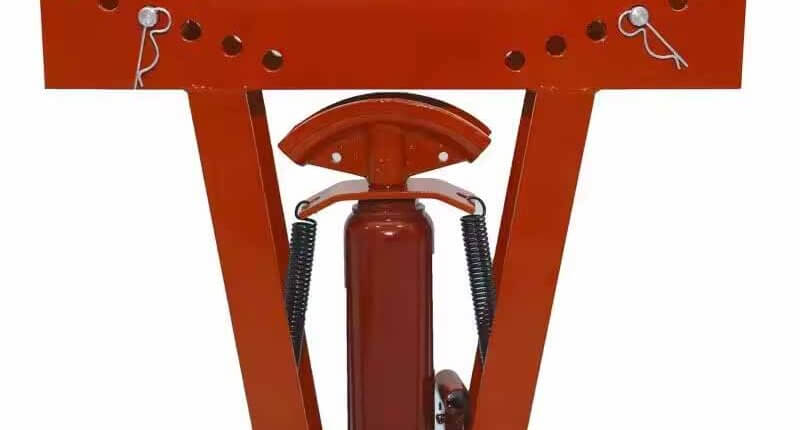
Hydraulic Press Pipe Bender
Press bending is a very simple way to bend pipes, you can use a hydraulic press and the simple bend die to press against the tube or pipe which is fixed on the bending tooling and forces it to conform to the shape.
How to Use Hydraulic Press Pipe Bender?
Using the hydraulic press to bend the pipe is very easy, let us have a look.
- Install: Install the simple hydraulic press, including the press die, bending die, and some other accessories.
- Position the Pipe for Bending: You need to mark the right bending position manually and then insert the pipe between the press die and bending die.
- Start to Bend: Use the bending mechanism on the hydraulic press and then start to bend.
- Release the Hydraulic Pump: Finally, you need to get the bent pipe, so you need to release the hydraulic pump and get the pipe.
The Advantages of Hydraulic Press Pipe Bender
- Low Cost: Only need simple tooling can achieve bending.
- Easy to Operate: No need special train, anyone can easily handle it.
The Disadvantages of Hydraulic Press Pipe Bender
- Poor Accuracy: This tooling is controlled by the operator, with no accuracy measurement.
- Easy to Break: The pipe bent on this tooling is easy to crush.
- Low Efficiency: Very low efficiency, controlled by humans, so its efficiency is dependent on how fast you are.
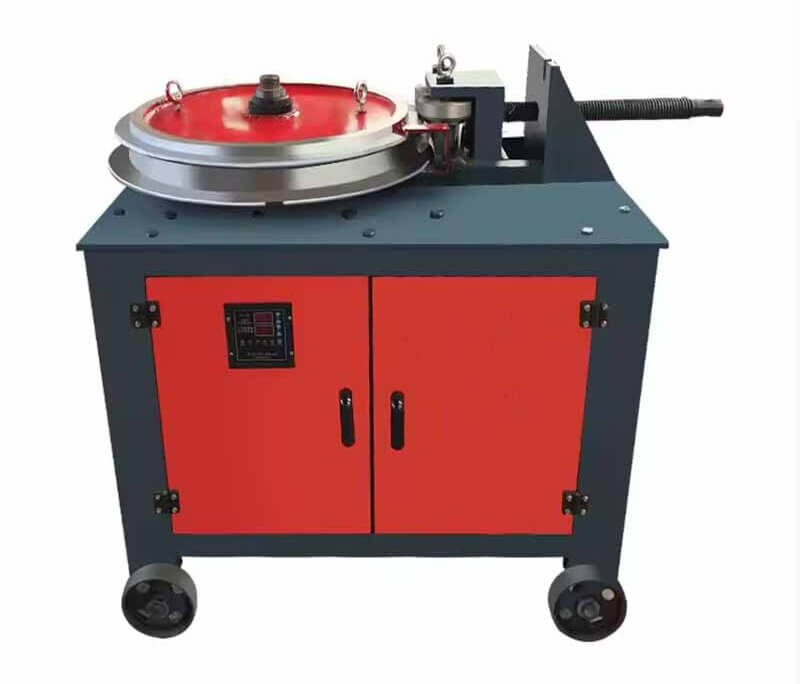
Rotary Draw Bender
A rotary draw bender is a type of simple bending machine, that has a clamping die, a pressure die, and a radius die. Bending by this machine is more accurate than the hydraulic press bender.
How to Use Rotary Draw Bender?
- Prepare the Machine: Before using, make sure the rotary draw bender is properly set up and all the clamps, supports, and dies are adjusted and ready for work.
- Prepare the Pipe: Mark the pipe where you want to bend, clean, and lubricate the pipe if necessary.
- Secure the Pipe: Insert the pipe into the clamping mechanism and tighten the clamp to hold the pipe in place.
- Select the Bend Die: Choose the appropriate bend die to form the desired bend radius and angle. Ensure that the die is securely mounted and aligned with the pipe.
- Start to Bend: Start the machine to begin the bending process. The machine will rotate the bend die while applying pressure to the pipe, and finally form to your desired shape.
- Remove the Pipe: Release the clamping mechanism and remove the bent pipe from the machine.
Advantages of Rotary Draw Bender
- Precise Bends: Bend pipe by rotary draw bender offers exceptional accuracy and repeatability.
- Efficiency: With fast cycle times and efficient operation, rotary draw benders can bend pipes at high speed.
Disadvantages of Rotary Draw Bender
- Cost: The rotary draw bender has a higher purchase cost than the simple bending machine.
- More Tooling: For each different shape/bends, and different diameters, you will need a corresponding tooling.
- Limited Flexibility: Rotary draw bender only can be used to bend pipes, and can not provide other extra customization services.
Compression Tube Bender
Compression tube bender is one of the pipe bending machines to bend metal pipes and tubes. This method of bending pipes was commonly used in the past, but now it is rarely used.
How to Use Compression Tube Bender?
- Prepare the Pipe: Use a pipe cutting machine to cut the pipe to the desired length, and clean the pipe ends if any burrs.
- Select the Bending Die: Choose the pipe bending die that is suitable for the pipe diameter and bend radius.
- Insert the Tube: Insert one end of the tubing into the bender, ensuring that it sits flush against the bending die.
- Place the Pipe: Place the pipe at the right position, so that the point at which you want the bend aligns with the center of the bending die.
- Secure the Pipe: Secure the pipe in place to prevent movement during bending.
- Start the Bender: Operate the hydraulic pump to compress the tubing against the bending die, and apply gradual pressure until the tubing bends to the desired angle.
Advantages of Compression Tube Bender
- Easy to Use: Compared with some precision industrial pipe bending machines, compression tube benders are easy to set up.
- Fast Speed: Compared with many pipe bending machines with simple settings, compression tube bending machines can produce bends faster.
Disadvantages of Compression Tube Bender
- Limited Working Capacity: It is only suitable for pipes with limited diameter and not suitable for small bending radii.
- Damage Risks: Pipe bent by a compression bender has the risk of getting damaged.
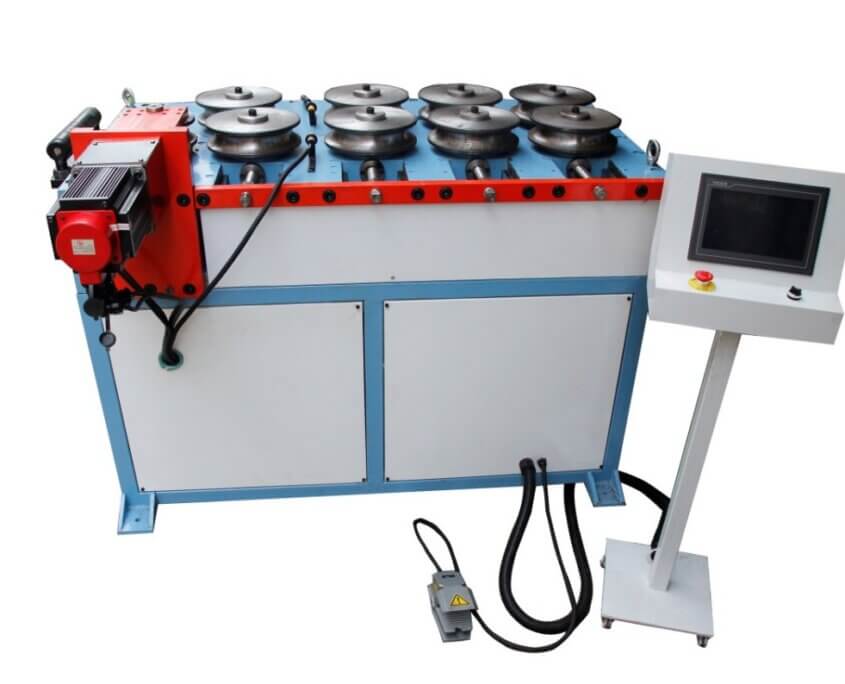
Pipe Roller Machine
A pipe roller machine is also a common equipment that is used to bend and form the metal pipe. This machine applies force to the pipe as it passes through a series of rollers and forms the pipes like a coil.
How to Use Pipe Roller Machine?
- Setup: Put the machine on the flat ground. Adjust the rollers and guides according to the diameter and curvature required for the pipe you are bending.
- Loading: Insert one end of the pipe into the machine’s rollers. Ensure it is securely held in place to prevent slipping during bending.
- Bending: Start the machine and gradually feed the pipe through the rollers while applying pressure. Use the machine’s controls to adjust the speed and pressure as needed.
- Unloading: Carefully remove the bent pipe from the machine, taking care not to damage the newly formed curves.
Advantages of Pipe Roller Machine
- Versatility: Without changing bend tooling, you can bend different pipe sizes.
- Multifunctionality: Can bend pipes in different directions.
- Cost: Compared to mandrel bender, pipe roller bender is more affordable.
Disadvantages of Pipe Roller Machine
- Low Speed: Compared with other mechanized pipe bends, this method bends pipes at low speed.
- Accuracy: It takes several trial and error attempts to achieve accurate results.
- Bending Risks: If you are going to bend a small radius or thin tubes, this method has a high chance of damaging the tube.
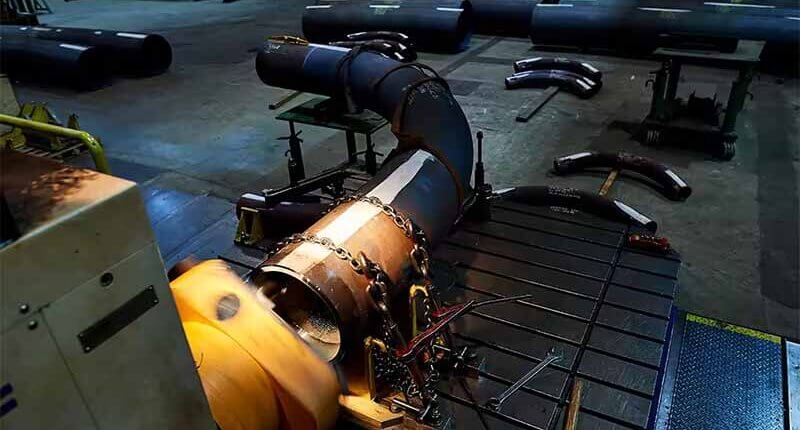
Induction Tube Bending Machine
Induction tube bending machines are specialized equipment used to bend metal tubes using electromagnetic induction heating. This process involves heating the metal tube at specific points to make it more pliable, allowing for precise bending without deformation or weakening of the material.
How to Use Induction Tube Bending Machine?
- Set Up the Machine: Adjust the machine settings according to the specifications of the tube, including the desired bend angle, radius, and heating temperature.
- Position the Tube: Place the tube in the machine’s bending mechanism, ensuring that it is securely held in place and aligned properly with the bending dies.
- Heat the Tube: Activate the machine’s electromagnetic heating system to heat the specific points on the tube where the bends are required. Monitor the temperature closely to avoid overheating or damaging the tube.
- Bend the Tube: Once the tube reaches the appropriate temperature, start the bending mechanism to gradually bend the tube to the desired angle.
- Cool the Tube: After bending, allow the tube to cool naturally or use a cooling system to expedite the process. This helps to set the shape of the bends and prevent distortion.
Advantages of Induction Tube Bending Machine
- Low Bending Force Requirement: Bending tube by induction bender does not require much force.
- Large Bending Force: This bending machine provides enough strength to bend a high wall-thickness tube.
Disadvantages of Induction Tube Bending Machine
- Material Damage Risks: Bending pipe with an induction pipe bending machine may have the risk of damaging the pipe’s structural integrity.
- Impact on Pipe Surface: High temperatures will leave visible stains on the surface of the pipe.
- Unstable Size: After cooling, the size of the pipe and bend can vary, and may not fit the expected size.
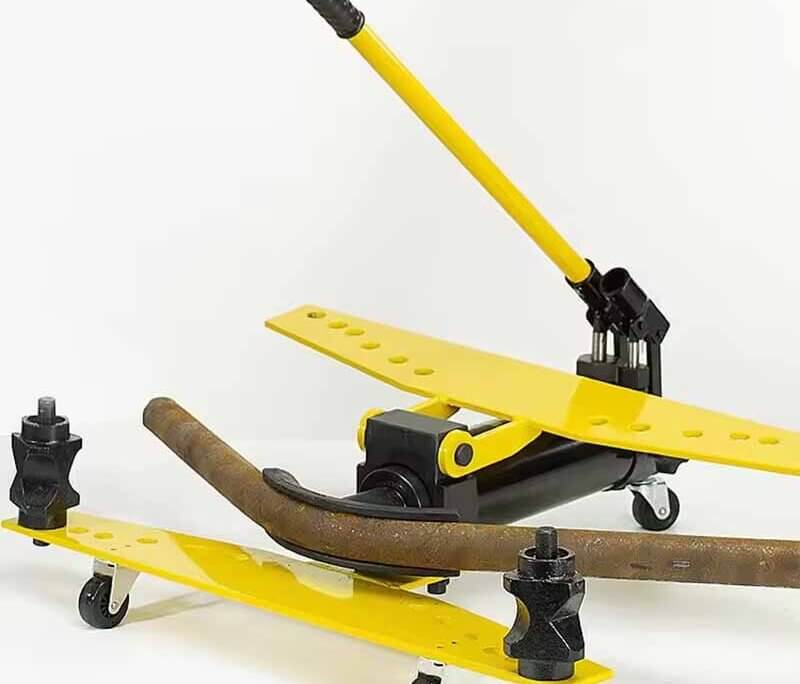
Ram Bender
Ram bender is also a simple pipe bending machine that is used for bending metal pipes. This machine provides fast bending, but not accurate.
How to Use the Ram Bender?
- Install the machine the flat and smooth ground.
- Install the counter die and press die on the machine.
- Insert the pipe into the bending die, ensuring it is aligned properly.
- Active the hydraulic ram to the pressure die to apply pressure to the pipe, gradually bending it to the desired angle.
- Release the pressure on the hydraulic ram and remove the bent pipe from the machine.
Advantages of Ram Bender
- Easy to Use: This machine is very easy to use,
- Fast Bending: The setup of the machine is very easy, so the bending is very simple, and the bending speed is fast.
- Low Cost: Ram bender is cost lower than some industrial pipe bending machines.
Disadvantages of Ram Bender
- Pipe Deformation: Bending pipes on a ram bender will cause pipe collapse.
- Low Accuracy: Pipes bent on the ram bender do not have high accuracy.
The Application of Pipe Bending Machine
Pipe bending machines have a wide range of applications across various industries. Anywhere you need to use a metal pipe to form the shape, you will need this equipment. Here are some applications that use the pipe bending equipment a lot.
Piping System
The pipe bending equipment is widely used to bend plumbing, HVAC (heating, ventilation, and air conditioning), and industrial processes.
Automotive Industry
In the auto industry, the tube pipe bender is used for bending exhaust systems, roll cages, chassis components, and other structural elements. This industry mainly uses mandrel benders to bend pipes with the exact dimensions and angles.
Aerospace and Aviation
CNC pipe bending machine is widely used in this industry to bend aircraft frames, hydraulic tubing, fuel lines, and other components. High precise bending can meet the strict quality standards of this industry.
Furniture and Architectural Design
In furniture manufacturing and architectural design, pipe bending machines are used to bend metal structures for chairs, tables, handrails, and decorative elements.
Oil and Gas Industry
The tube bender machine used in the oil and gas industry is for fabricating pipelines, wellheads, drilling equipment, and other infrastructure. Bent pipes are essential for navigating around obstacles, following terrain contours, and optimizing the layout of pipelines in various environments.
Medical Equipment
Pipe bending machine used in medical equipment is used to bend the components of medical devices, laboratory equipment, and diagnostic instruments.
Construction and Structural Engineering
Pipe bending machines used in the construction industry are for bending structural components, handrails, scaffolding, and other architectural features. Bent pipes are often used to create curved or spiral staircases, domes, and arches in buildings and bridges.
Factors Need to Consider When Choosing Pipe Bending Machine
Customers from various industries require tube bending machines, but their needs and priorities vary. So, what factors should be considered before making a purchase?
Cost
For any of the projects, you will have a budget. So, consider your budget first, especially when your bending requirements are high, this means you will need better technology.
Accuracy
Each different project may have different requirements for accuracy, so before purchasing the pipe bending machine, you need to confirm your request for accuracy, so that you can look for the machine accordingly.
Working Capacity
Different projects will have different pipes that need to be bent, so confirm the Maximum size of the pipe you want to bend on the machine and then tell this information to the supplier and ask them to choose the machine for you.
Bending Speed
First, confirm your production capacity requirements, then check if the pipe bending machine speed can meet your requirements.
Material Compatibility
Consider how many types of pipe material you want to bend on this machine, then ask your supplier whether their machine can be compatible with all your materials.
TubeBenderN is the pipe bending machine manufacturer in China, tell us your bending requests, and we will find the best pipe bending solutions for you!
You may also interested in:
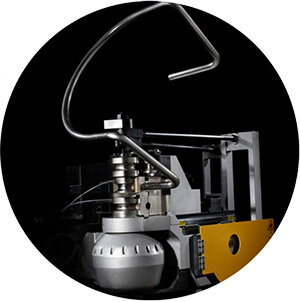
Denis Lau
Denis Lau has 20 years of work experience in the metal processing industry. His major in university was mechanical engineering, and after graduation, he started from the bottom of the workshop, gaining extensive hands-on professional experience and the ability to tackle challenges from various industries.


